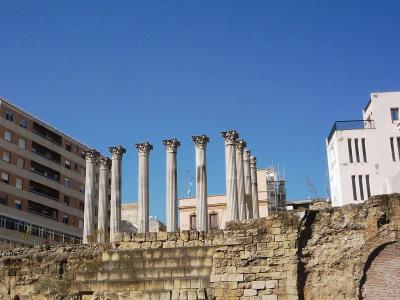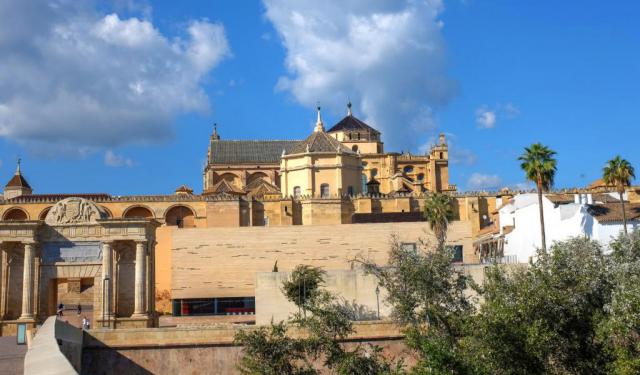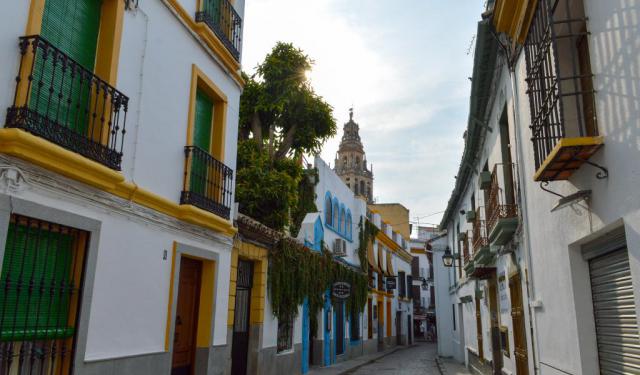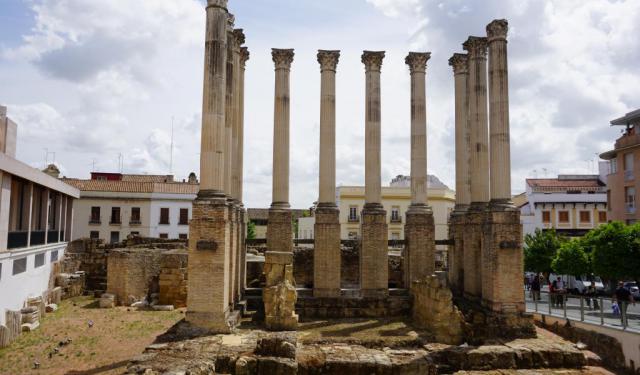Templo Romano (Roman Temple), Cordoba
During the expansion of the Cordoba City Hall in 1950, the remains of a Roman Temple (Templo Romano) were unearthed. It was not the only temple in town, but there was none like this one. It was 105 feet long and 53 feet wide. It was estimated that construction had begun during the reign of Emperor Claudius, perhaps around 50 AD.
The fashion of the temple was Pseudoperipterus (columns engaged and embedded on the walls except in the front) and Hexastyle (six free-standing columns supporting a portico). The columns were Corinthian. The area around the temple was estimated to be the site of the town's forum when the city was titled Colonia Patricia by Rome.
The primary construction material used was high-quality marble. There was marble in the walls, columns, roof, and entablature. The temple stood by the west walls in the center of an artificial terraced square. The square was closed on three sides. The front of the temple faced the neighboring circus. The temple fell into disuse in the 4th century.
The reconstruction work of the Roman Temple was carried out in the middle of the 20th century, between the 50s and 60s, performed by the archaeologist Antonio García Bellido and the architect Félix Hernándezed. The restored ruins of the Roman Temple consist of 12 massive columns standing evenly in a 3/4 square. At night the columns are illuminated in warm, changing colors.
The remains of the building are its foundation, the stairs, the altar, and some shafts of columns and capitals. The original fragments of the temple, such as parts of drums or capitals, can be seen. Some pieces are shown in the Archeological Museum. Others are planted at various places around town, such as a fluted Corinthian column in the Plaza de la Doblas.
The fashion of the temple was Pseudoperipterus (columns engaged and embedded on the walls except in the front) and Hexastyle (six free-standing columns supporting a portico). The columns were Corinthian. The area around the temple was estimated to be the site of the town's forum when the city was titled Colonia Patricia by Rome.
The primary construction material used was high-quality marble. There was marble in the walls, columns, roof, and entablature. The temple stood by the west walls in the center of an artificial terraced square. The square was closed on three sides. The front of the temple faced the neighboring circus. The temple fell into disuse in the 4th century.
The reconstruction work of the Roman Temple was carried out in the middle of the 20th century, between the 50s and 60s, performed by the archaeologist Antonio García Bellido and the architect Félix Hernándezed. The restored ruins of the Roman Temple consist of 12 massive columns standing evenly in a 3/4 square. At night the columns are illuminated in warm, changing colors.
The remains of the building are its foundation, the stairs, the altar, and some shafts of columns and capitals. The original fragments of the temple, such as parts of drums or capitals, can be seen. Some pieces are shown in the Archeological Museum. Others are planted at various places around town, such as a fluted Corinthian column in the Plaza de la Doblas.
Want to visit this sight? Check out these Self-Guided Walking Tours in Cordoba. Alternatively, you can download the mobile app "GPSmyCity: Walks in 1K+ Cities" from Apple App Store or Google Play Store. The app turns your mobile device to a personal tour guide and it works offline, so no data plan is needed when traveling abroad.
Templo Romano (Roman Temple) on Map
Sight Name: Templo Romano (Roman Temple)
Sight Location: Cordoba, Spain (See walking tours in Cordoba)
Sight Type: Attraction/Landmark
Guide(s) Containing This Sight:
Sight Location: Cordoba, Spain (See walking tours in Cordoba)
Sight Type: Attraction/Landmark
Guide(s) Containing This Sight:
Walking Tours in Cordoba, Spain
Create Your Own Walk in Cordoba
Creating your own self-guided walk in Cordoba is easy and fun. Choose the city attractions that you want to see and a walk route map will be created just for you. You can even set your hotel as the start point of the walk.
Cordoba Introduction Walking Tour
Córdoba treats history like a sculptor treats marble-layered, chiseled, and ever revealing something new. Situated in Andalusia, this city has seen empires rise, and its story spans over 2,200 years. Originally named Qart Juba by the Carthaginians, it was refounded in 206 BC by the Romans as Corduba. As the capital of the province Hispania Ulterior, it had to prove its reputation by having its... view more
Tour Duration: 2 Hour(s)
Travel Distance: 3.3 Km or 2.1 Miles
Tour Duration: 2 Hour(s)
Travel Distance: 3.3 Km or 2.1 Miles
Cordoba Jewish Quarter Walk
Córdoba’s Jewish Quarter is one of the most atmospheric and historically rich districts of the city, located within the UNESCO-listed historic center. Its origins trace back to the Roman period, but it flourished most prominently during the Middle Ages, when Córdoba stood as one of the most important intellectual and cultural centers in Europe.
Under Muslim rule from the 8th to the 13th... view more
Tour Duration: 1 Hour(s)
Travel Distance: 0.4 Km or 0.2 Miles
Under Muslim rule from the 8th to the 13th... view more
Tour Duration: 1 Hour(s)
Travel Distance: 0.4 Km or 0.2 Miles
Ancient Roman Sites Walking Tour
Under all in Cordoba lies a once redoubtable Roman strongpoint. After Scipio's defeat of the Carthaginians in Llipa, the victorious Romans set up camp by the Guadalquivir River.
Under Augustus, the city gained the status of Colonia Patricia. A perimeter wall was built touching the Guadalquivir River. There were two forums, colonial and provincial. A large amphitheater has been uncovered.... view more
Tour Duration: 1 Hour(s)
Travel Distance: 2.5 Km or 1.6 Miles
Under Augustus, the city gained the status of Colonia Patricia. A perimeter wall was built touching the Guadalquivir River. There were two forums, colonial and provincial. A large amphitheater has been uncovered.... view more
Tour Duration: 1 Hour(s)
Travel Distance: 2.5 Km or 1.6 Miles






